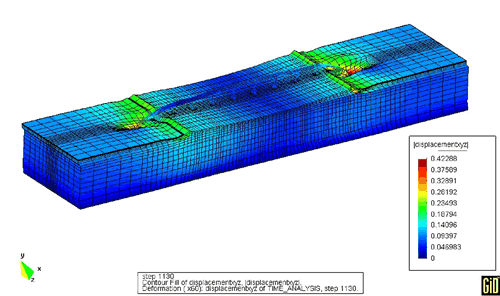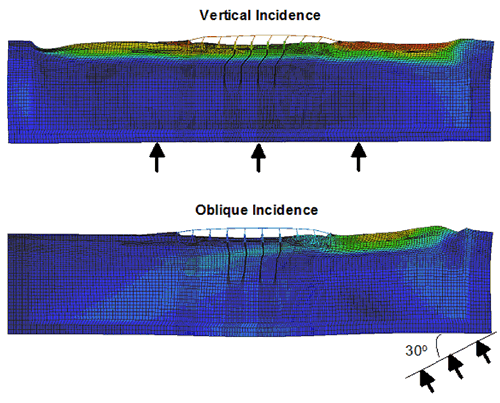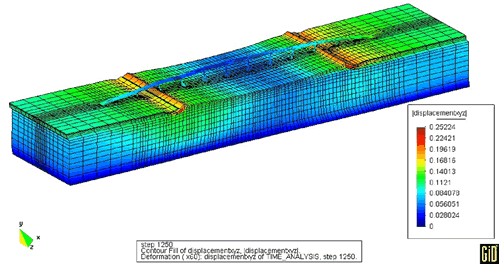| Project Title/ID Number |
3D Simulation of Seismic
Ground Deformation in OpenSees—2202003 |
| Start/End Dates |
10/1/03—9/30/04 |
| Project Leader |
Ahmed Elgamal (UCSD/F) |
| Team Members |
Jinchi Lu (UCSD/GS), Zhaohui
Yang (UCSD/PD), Linjun Yan (UCSD/GS) |
F=faculty; GS=graduate student; US=undergraduate student; PD=post-doc; I=industrial
collaborator; O=other
Click on images to enlarge in a new window
1. Project Goals/Objectives:
The Y7 project is mainly focused on developing a number of computational
simulation capabilities in OpenSees and applications on 2D/3D bridge-foundation-ground
systems. This project includes the following specific tasks:
-
Analyze the
seismic behavior of a large-scale 3D bridge-foundation-ground system.
Investigate the dynamic interaction between abutments and bridge
structure.
-
Refine solid-fluid fully coupled formulation and implement
new u-p elements for more robust soil liquefaction simulations (in collaboration
with Dr.
Frank McKenna).
-
Assist in 2D modeling of Humboldt Bay Bridge and synthesizing
PEER probabilistic seismic analysis framework (in collaboration with
Prof. Joel Conte).
-
Develop and implement numerical algorithms for parameter
sensitivity analysis of seismic ground response (in collaboration with
Prof.
Joel Conte).
-
Improve application of spatial definition of ground
motion (Domain Reduction Method) on a fully nonlinear 2D bridge-foundation-ground
system (in collaboration
with Prof. Jacobo Bielak).
2.
Role of this project in supporting PEER’s mission
(vision):
The simulation capabilities developed are important components in the
PEER computational framework OpenSees for Performance-Based Earthquake
Engineering (PBEE) applications. These capabilities are being verified
and utilized by PEER researchers in conducting computational simulations
such as the Humboldt Bay Bridge testbed.
3. Methodology Employed:
The PEER computational program, OpenSees, is employed as the main research
platform.
4. Brief Description of past year’s accomplishments
(Year 6) & more detail on expected Year 7 accomplishments:
In Year 6, a large-scale 3D model of the Humboldt Bay Bridge was developed
using OpenSees. This model includes many advanced nonlinear modeling capabilities
available in OpenSees, such as nonlinear fiber beam-column elements (for
bridge piers and foundation piles) and pressure-dependent soil material
models. The soil models were partially calibrated based on experimental
data from other PEER research projects (e.g., soil sample test data from
UC Berkeley, centrifuge test results from UC Davis). Appropriate transmitting
boundaries were also included to allow radiation of seismic waves. Preliminary
simulation results indicated that the presence of bridge abutments may have
a paramount influence on the overall response of the bridge-ground system.

Fig. 1. Deformed shape of OpenSees 3D bridge-foundation-ground model subjected
to base excitation
In addition, in Year 6, the Domain Reduction Method (developed by Prof.
Jacobo Bielak) was employed to study the seismic response of a 2D bridge-foundation-ground
system subject to spatially varying earthquake excitation. In this model,
the interior domain, including the bridge, pile foundations, and surrounding
soil, was defined to be fully nonlinear; whereas the exterior domain was
linear elastic with uniform properties. Simulation results using this model
showed that the seismic behavior of a bridge can be very sensitive to the
angle of incidence of the incoming seismic wave. The commonly used assumption
that the structure is only subjected to vertically propagating seismic waves
is often non-conservative.
This Y7 project is a continuation of the Y6 project.
The specific tasks in Year 7 are:
-
Investigate the dynamic interaction between
abutments and bridge structure. For this study, another 3D bridge-ground
model was built (Fig. 3), which
is identical to the previous one (Fig. 1) except that the bridge abutments
were replaced by piers. The difference in bridge response between these
two models highlights the influence of abutments on the system behavior.
-
Refine solid-fluid fully coupled formulation and implement new u-p elements.
In collaboration with Dr. Frank McKenna, modifications are
being made in
OpenSees to improve the robustness of the existing implementation
of the u-p formulation. Moreover, a 9-4-node element (9 nodes for solid
and 4
nodes for fluid) will be implemented. This element is best known for
its reliable
performance in simulating dynamic response of saturated soil including
liquefaction. Currently, only a 4-4-node element (u-p formulation)
exists in OpenSees.
-
Extensive collaboration is ongoing with Prof. Joel Conte
to exercise the PEER PBEE methodology framework on the Humboldt Bay Bridge
testbed.
This 2D model of the Humboldt Bay Bridge includes many developed
soil nonlinearity algorithms and transmitting boundary effects. It is anticipated
that all
major tasks of the testbed will be completed in Year 7.
-
Finally,
in close collaboration with Prof. Conte, numerical algorithms have been
developed for direct differentiation of a multi-surface
cyclic plasticity model to obtain consistent stiffness operator
as well as
the sensitivity of individual model parameters (e.g., shear stiffness,
shear
strength, etc.) to global response quantities (e.g., acceleration,
displacement, etc.). These algorithms have been implemented and
verified in OpenSees.
-
Preliminary results from the application
of the Domain Reduction Method (Fig. 2) show that a significant impedance
contrast between
the nonlinear
interior domain and the linear exterior domain can introduce
spurious reflected waves at the interior/exterior boundary. Methods are
being sought to reduce
such undesirable effects.

Fig. 2. OpenSees 2D bridge-foundation-ground model subjected to vertical
or oblique plane shear wave

Fig. 3. Deformed shape of OpenSees 3D bridge-foundation-ground model
(without abutments) subjected to base excitation.
5. Other Similar Work Being Conducted Within and Outside
PEER and How This Project Differs:
Large-scale 3D computer simulation of seismic wave propagation and nonlinear
site response effects are only at the very early stage of development.
Related work is being conducted at Carnegie Mellon Univ. for linear and
mildly nonlinear scenarios. A main goal of this project is to more accurately
model soil-structural interaction response ranging from linear to highly
nonlinear scenarios (e.g., liquefaction). Furthermore, application of the
Domain Reduction Method in highly nonlinear site response simulations has
not been done before. Advanced PEER research in this area is being conducted
by Prof. Jeremic at UC Davis.
6. Plans for Year 8 if project is expected to be continued:
For Year 8, it is proposed to conduct research on:
-
Refining the 3D bridge
model to include solid-fluid fully coupled elements for simulating soil
liquefaction and related effects on bridge-foundation
systems.
-
Using the 3D model to carry out probabilistic seismic hazard
and engineering demand analyses, following the PEER PBEE methodologies.
-
Using the 3D model to study the sensitivity of global response quantities
on soil material parameters.
-
Helping test and debug many existing and
new components of OpenSees through modeling of the Humboldt Bay Bridge.
7. Describe any actual instances where you are aware your
results have been used in industry:
8. Expected Milestones & Deliverables:
-
11/01/03: Refined the 3D Humboldt Bay Bridge model to be fully
nonlinear (both soil and structure).
-
02/01/04: Conducted 3D analysis of
abutment permanent displacement and impact on super-structure performance.
-
05/01/04:
Improve fully coupled u-p formulation and implement 9-4 node fully coupled
element.
-
07/01/04: Improve application of Domain Reduction Method.
-
09/01/04: Documentation
of OpenSees developments and a number of journal papers and conference
papers.


